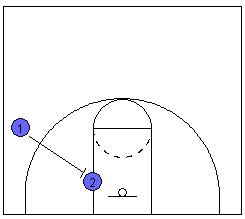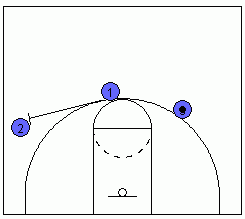Bobby Knight's Simple Offense Tip On Screens &
Why You May Never Use Down Screens Again
 An example of this would be the down screen. A player on the wing sets a screen for a player on the block.
An example of this would be the down screen. A player on the wing sets a screen for a player on the block.
If you think about it, the player has to do a full 180 degree turn in order to become a scoring threat. This does a few things:
- Less efficient and less accurate shots, because of all of the body movement. It also gives the defender more time to get a hand up to contest the shot. Even at the pro level, a contested shot has much lower percentage than an open shot. Check out these articles for more on that:
Contesting Shots - Decrease Your Opponent's Shooting Percentage by 25%
Open Vs. Contested Shots - Sacramention Kings' 2004/2005 Statistics
- Offensive player loses offensive advantage to drive to the basket. As mentioned above, this gives more time for the defender to recover which will make it harder for the offensive player to drive by the defender.
 Instead, Bobby Knight likes screens where the players going towards the basket. An example of this would be a Away Screen. This is when a player from the high post goes to set a screen for a player in the wing/baseline area. This will accomplish the opposite of the down screen.
Instead, Bobby Knight likes screens where the players going towards the basket. An example of this would be a Away Screen. This is when a player from the high post goes to set a screen for a player in the wing/baseline area. This will accomplish the opposite of the down screen.
- More accurate and efficient shots. This will give the player momentum heading to the basket. With this screen, the player can quickly square to the basket and shoot with a higher percentage. Personally, I feel like I develop a better rhythm for the shot when going towards the basket rather than away from the basket.
- Offensive player gains offensive advantage to drive to the basket. In order to close out on the shot in time, the defender has run very hard which will often force him to over-pursue and the offensive player can easily fake the shot and drive to the basket.
If you run a motion offense or a patterned offense that uses lots of down screens, you might want to consider emphasizing and incorporating other types of screens instead.
Personally, after hearing this advice, I will think twice about how I implement a motion offense and what screens I teach/emphasize.
What are your thoughts about this? Let us know by leaving your comments, suggestions, and questions...
|
||||||||||||||||||||||||



 Facebook (145k Followers)
Facebook (145k Followers) YouTube (152k Subscribers)
YouTube (152k Subscribers) Twitter (33k Followers)
Twitter (33k Followers) Q&A Forum
Q&A Forum Podcasts
Podcasts